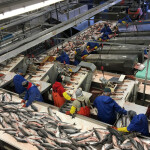Steve Creech has worked in small-scale, coastal fisheries development in South Asia for more than 25 years. Currently he designs and coordinates the Sri Lankan blue swimming crab fisheries improvement project and the Sri Lankan longline tuna and billfish FIP on behalf of the members of each FIP. He can be contacted at [email protected]
The Sri Lankan government’s decision to proscribe motorized and mechanized bottom-trawling establishes a new milestone against which evaluate initiatives across the Asian region, designed to deliver sustainably sourced seafood to markets in Europe and North America. Species-rich and highly productive tropical fisheries need species-specific fishery solutions if they are to maximize sustainable economic yields across multiple, interwoven populations of fish.
Bottom-trawling for prawns – South and Southeast Asia’s top export commodity – regularly tops the list of the world’s most wantonly wasteful fishing methods. Ecologically alarming levels of bycatch - as high as 20:1 – have been associated with prawn trawling in tropical fisheries. Every single one of the hundred or so species bundled up in that 20 kilograms of bycatch has an ecological role. Many of the immature and juvenile fish, crabs, prawns, and cuttlefish in a prawn trawl would have gone on to become part of the catch of one or more locally important fisheries.
The decision to prohibit motorized and mechanized bottom-trawling in Sri Lankan waters is a surprising outcome of the Sri Lankan blue swimming crab fishery improvement project (FIP). The FIP was initiated in 2013 by the National Fisheries Institute’s Crab Council in partnership with the Seafood Exporters’ Association of Sri Lanka and Taprobane Seafood Pvt Ltd. The FIP subsequently received investments from leading U.S. crab importers, including Chicken of Sea Frozen Foods and Santa Monica Seafood. Bilateral and multilateral aid projects including the International Labour Organisation of the United Nations and the Bay of Bengal Large Marine Ecosystem Program have also invested in the FIP, as has the government of Sri Lanka.
Central to the FIP is the idea of collaboration between local crab manufacturers, government authorities and blue swimming crab fishing communities. The FIP’s objectives are to improve the biological and ecological status of the fishery and introduce management measures to maintain the status of the fishery at a level equivalent to a sustainably managed fishery. The involvement of fishing communities in FIP design, implementation, and decision-making has been instrumental in ensuring the integrity of the FIP. Community involvement has ensured that the FIP drives real improvements to the fishery, including the recent bottom-trawling ban.
Back in 2013, the critical issue that fishing communities wanted to address to improve the blue swimming crab fishery was illegal, unreported and unregulated (IUU) fishing by Tamil Nadu trawlers in Sri Lankan waters. There was no direct relationship with the crab fishery. But indirectly, Sri Lankan fishermen were forced to stay out of the water when as many as a thousand Tamil Nadu vessels trawled illegally for prawns in Sri Lankan waters, in order to protect their crab gear from being destroyed.
For four years, the seafood industry, the government, and blue swimming crab fishermen lobbied and campaigned locally, provincially, nationally, bilaterally, and eventually internationally to end IUU fishing by Tamil Nadu trawlers in Sri Lankan waters. In November of last year, a delegation of Sri Lankan fishermen met Tamil Nadu trawler owners and then the Indian Minister for Foreign Affairs Sushma Swaraj in New Delhi. Sri Lankan fishermen demanded an immediate end to IUU fishing by Tamil Nadu trawlers in in Sri Lankan waters.
However, the success of the campaign opened the door for Sri Lankan boat owners to begin operating their own trawl nets in Sri Lankan waters. Traditional, small-scale net fishermen were again for forced out of the water to protect their nets from damage or destruction by local trawl-net fishing. Again blue swimming crab fishermen asked for support. Again the collective strength of the FIP – combining producers, processors and regulators – was used to good effect.
The belief that the seafood industry and consumers in Europe and North America can somehow drive an international movement for sustainably sourced seafood is almost 20 years old. The concept of fishery improvement projects or FIPs arose out of this conviction. The failure of many FIPs to improve the status and management of tropical fisheries has rightly led to questions being raised about the validity of the FIP concept and whether industry and consumers can actually encourage sustainable tropical fisheries.
The achievements of the blue swimming crab FIP over the past four years, which now includes the prohibition of bottom trawling, is testament to the fitness of FIPs to improve tropical fisheries. The crucial element in Sri Lanka is the involvement of blue swimming crab fishermen. To drive improvements to a fishery, a FIP must be credible. To be credible, a FIP must involve fishermen. The Sri Lankan blue swimming crab FIP has done is committed to this, and with the prohibition of bottom trawling, has another proof of credibility.





